Welcome back to Magic Gatherings!
Last Sunday I attended the Magic Origins Prerelease at my Friendly Local Game Store: Pandemonium Books and Games in Cambridge, MA, a lovely institution where you are as likely to find a pickup game of Warhammer or My Little Pony as you are to find Max Gladstone and Elizabeth Baer playing D&D together. With me was a Magic ingenue—none other than podcaster and pigeon love expert extraordinaire Tim Lanning. Tim is relatively new to Magic but was eager for his first tournament experience.
For a Sunday afternoon prerelease, Pandemonium drew a phenomenal crowd—almost 100 players, by my count. As is the case at many stores, Pandemonium allowed pre-registered players to choose a favorite color, and even applied personalized labels to the prerelease kits:
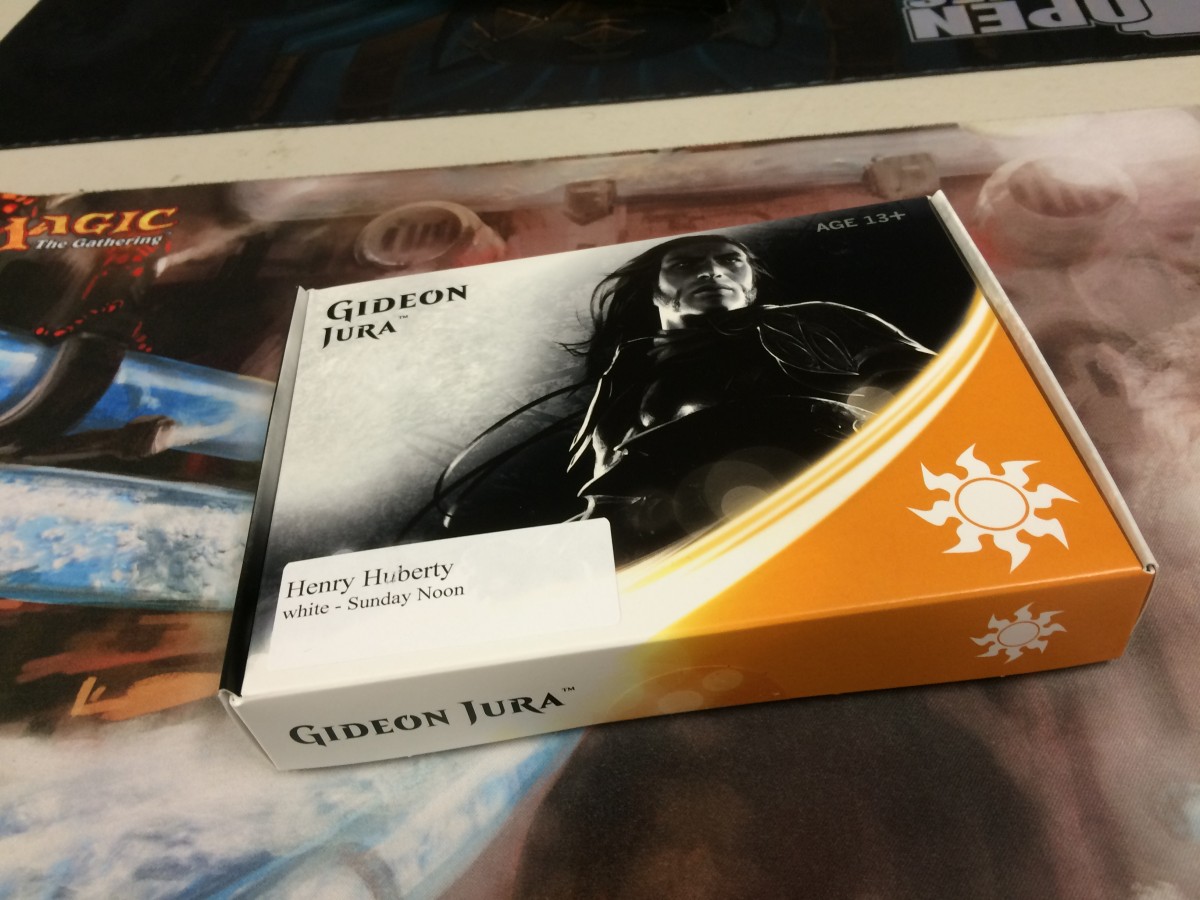 All in all, passing out product went pretty efficiently, considering the size of the crowd. Once everyone received their kits, we were able to turn to the business at hand: busting packs and building decks.
All in all, passing out product went pretty efficiently, considering the size of the crowd. Once everyone received their kits, we were able to turn to the business at hand: busting packs and building decks.
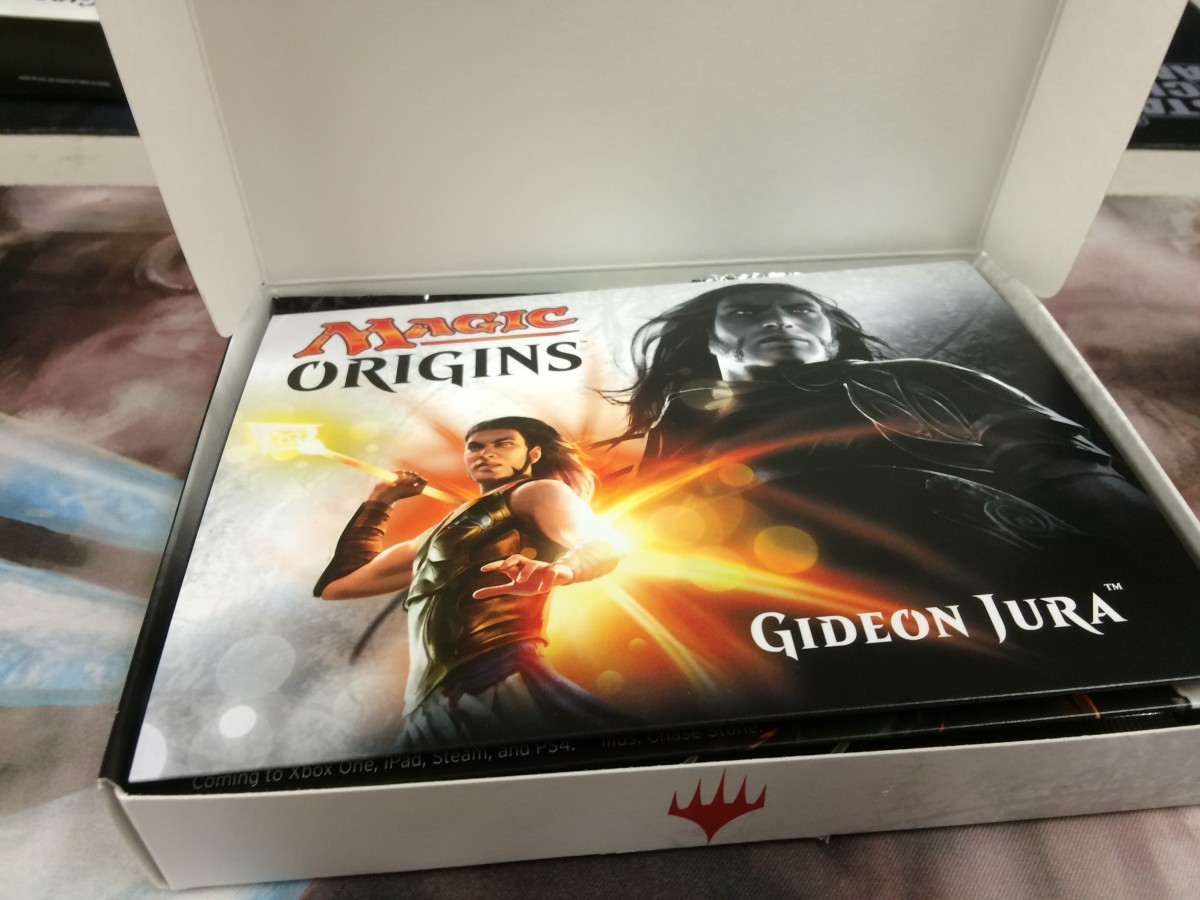 Each prerelease kit came packed with a story leaflet to relate the history of its respective planeswalker—one new aspect of the tighter cohesion between Magic’s backstory and the experience of playing the game. This particular leaflet tied key moments in Gideon’s life to actual game actions the player could take. For example, the player can represent being “Top Dog on the Streets” by having a creature they control become renowned; or, they can see Gideon’s moment of tragic hubris firsthand when two or more of their own attacking creatures die in one combat.
Each prerelease kit came packed with a story leaflet to relate the history of its respective planeswalker—one new aspect of the tighter cohesion between Magic’s backstory and the experience of playing the game. This particular leaflet tied key moments in Gideon’s life to actual game actions the player could take. For example, the player can represent being “Top Dog on the Streets” by having a creature they control become renowned; or, they can see Gideon’s moment of tragic hubris firsthand when two or more of their own attacking creatures die in one combat.
“Achievements” like these have been showing up on prerelease leaflets for at least the last few years, and they have frankly always felt a little contrived. (Previously, Wizards has tried to make the achievements matter by tying them to meta-contests like opening Innistrad’s Helvault or solving Ravnica’s Implicit Maze. These tasks were supposed to give extra bonus cards to prerelease attendees. Most stores I’ve ever been to just gave away the prizes and ignored the hokey nonsense.) The understated delivery here gives players who are seeking a more comprehensive story experience the chance to buy in, if they like. It’s a nice touch.
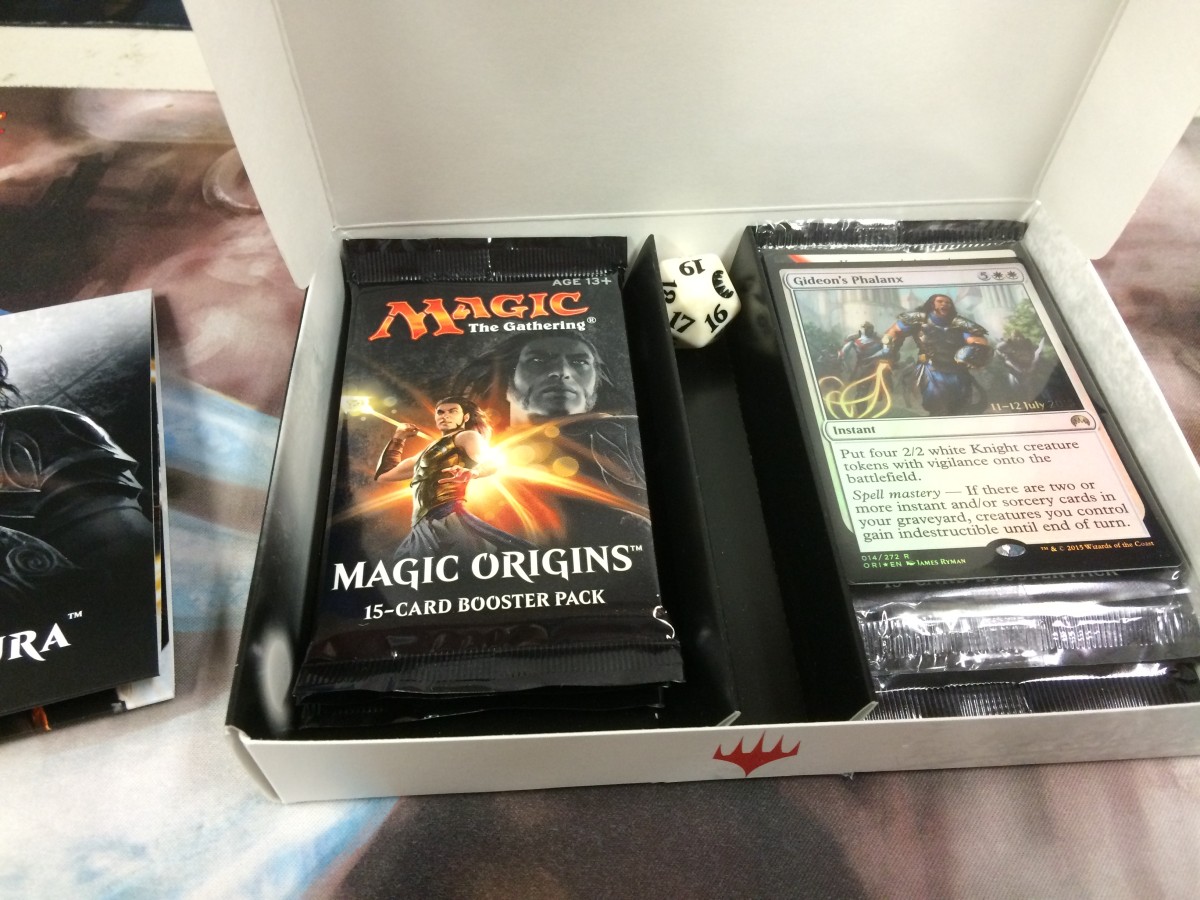 Inside the box, players get a spindown life counter and a punch of sweet new product. This time, Wizards gave a full six packs of the new set, plus a bonus “seeded” pack containing all white cards, including a foil promo. The seeded pack is designed to make sure you will be able to play the color you picked.
Inside the box, players get a spindown life counter and a punch of sweet new product. This time, Wizards gave a full six packs of the new set, plus a bonus “seeded” pack containing all white cards, including a foil promo. The seeded pack is designed to make sure you will be able to play the color you picked.
 I did pretty well with the cards in mine. [mtg_card]Gideon’s Phalanx[/mtg_card] is a bit expensive, and [mtg_card]Kytheon’s Tactics[/mtg_card] doesn’t fit in every deck. But [mtg_card]Suppression Bonds[/mtg_card] and [mtg_card]Swift Reckoning[/mtg_card] are primo removal spells, and [mtg_card]Sentinel of the Eternal Watch[/mtg_card] is an excellent creature.
I did pretty well with the cards in mine. [mtg_card]Gideon’s Phalanx[/mtg_card] is a bit expensive, and [mtg_card]Kytheon’s Tactics[/mtg_card] doesn’t fit in every deck. But [mtg_card]Suppression Bonds[/mtg_card] and [mtg_card]Swift Reckoning[/mtg_card] are primo removal spells, and [mtg_card]Sentinel of the Eternal Watch[/mtg_card] is an excellent creature.
With that out of the way, it was time to see what the rest of the pool offered—and, especially, to see if I opened anything sweet!
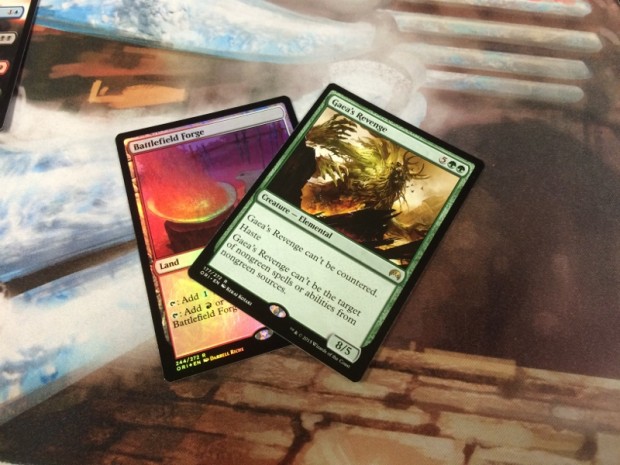 The first pack had a foil Battlefield Forge and a great green rare. Nice start!
The first pack had a foil Battlefield Forge and a great green rare. Nice start!
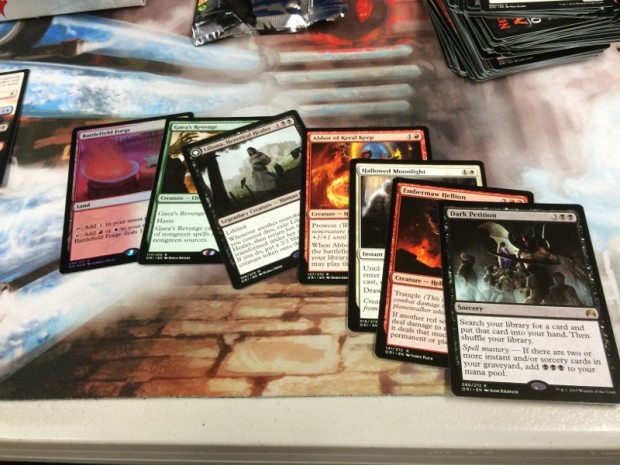 My other rares were a little less crazy, but I did open a [mtg_card]Liliana, Heretical Healer[/mtg_card]! Not bad, not bad. I’ll have to find a place for that Dark Petition in a Commander deck.
My other rares were a little less crazy, but I did open a [mtg_card]Liliana, Heretical Healer[/mtg_card]! Not bad, not bad. I’ll have to find a place for that Dark Petition in a Commander deck.
 The next step in building a sealed deck (which is the format for every prerelease) is to sort your cards. This helps you decide what colors you’ll wind up playing, as it’s easier to see what each color has to offer. Once you have piles sorted by color, it’s best to take a quick riffle through each pile to see what cards you’re most excited about. What do you really want to play? That initial “pop” factor is a useful signpost—it’s not right 100% of the time, but it will point you toward what you should focus on first, and spend the most time evaluating.
The next step in building a sealed deck (which is the format for every prerelease) is to sort your cards. This helps you decide what colors you’ll wind up playing, as it’s easier to see what each color has to offer. Once you have piles sorted by color, it’s best to take a quick riffle through each pile to see what cards you’re most excited about. What do you really want to play? That initial “pop” factor is a useful signpost—it’s not right 100% of the time, but it will point you toward what you should focus on first, and spend the most time evaluating.
Next it’s best to lay out potential decks in provisional builds. I made things easy on myself this time and assumed my white would make a good core for my deck. Again, that won’t always be the case, but it’s true often enough that it makes for the best starting point. And at a low-stakes, mostly-for-fun tournament like a prerelease, it’s not a disaster if the color you pick is a little worse than other colors.
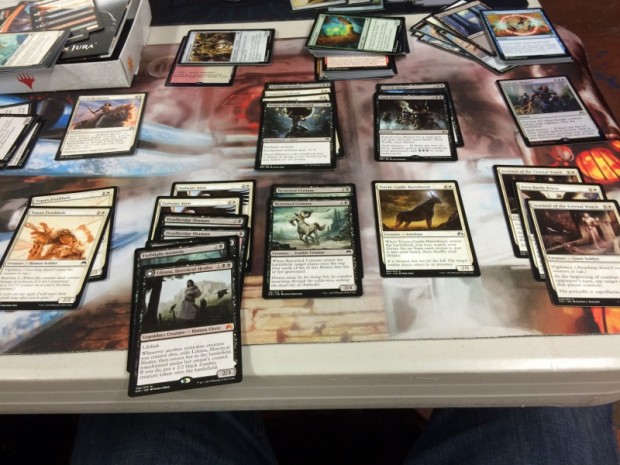 My white-black has a ton of three-mana creatures. Black brings a couple extra removal spells in [mtg_card]Unholy Hunger[/mtg_card] and [mtg_card]Weight of the Underworld[/mtg_card], and removal spells are always handy. I’m a little nervous that this build only has two two-mana creatures, so I might find myself playing from behind against an opponent who always has a two-mana creature on turn two. But it does offer two [mtg_card]Returned Centaur[/mtg_card]s, which block very well, and I’m very likely to have something on turn three—especially those [mtg_card]Deadbridge Shaman[/mtg_card]s, who really like blocking, dying, and forcing my opponent to discard an extra card.
My white-black has a ton of three-mana creatures. Black brings a couple extra removal spells in [mtg_card]Unholy Hunger[/mtg_card] and [mtg_card]Weight of the Underworld[/mtg_card], and removal spells are always handy. I’m a little nervous that this build only has two two-mana creatures, so I might find myself playing from behind against an opponent who always has a two-mana creature on turn two. But it does offer two [mtg_card]Returned Centaur[/mtg_card]s, which block very well, and I’m very likely to have something on turn three—especially those [mtg_card]Deadbridge Shaman[/mtg_card]s, who really like blocking, dying, and forcing my opponent to discard an extra card.
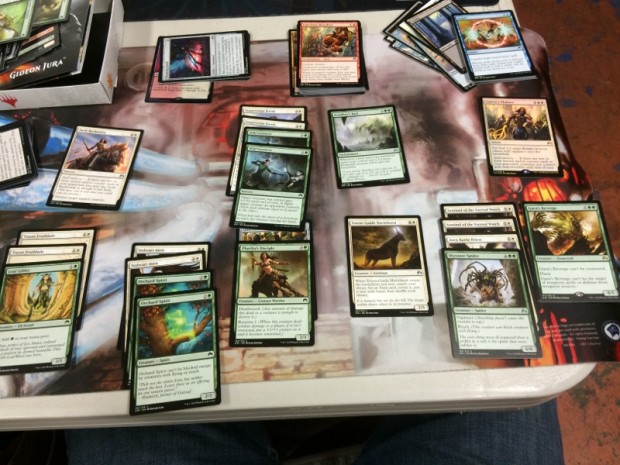 White-green adds an extra two-drop, [mtg_card]Leaf Gilder[/mtg_card], who even allows me to play more expensive spells sooner. The six- and seven-mana spells in this deck are very powerful, but I’m concerned that there are too many cards in the deck that are too expensive.
White-green adds an extra two-drop, [mtg_card]Leaf Gilder[/mtg_card], who even allows me to play more expensive spells sooner. The six- and seven-mana spells in this deck are very powerful, but I’m concerned that there are too many cards in the deck that are too expensive.
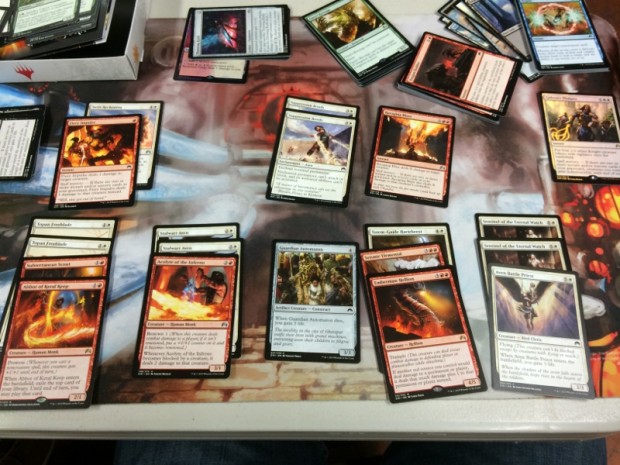 Red brings several powerful rares ([mtg_card]Abbot of Keral Keep[/mtg_card] and [mtg_card]Embermaw Hellion[/mtg_card]) to the party. It would also let me take advantage of that [mtg_card]Battlefield Forge[/mtg_card], which is important to note. But it’s just a bit thin on playable cards—even scraping into artifacts, I would be a few cards short from 23, which is the normal number of spells for a limited Magic deck. An extra [mtg_card]Akroan Sergeant[/mtg_card] and I might have wound up here.
Red brings several powerful rares ([mtg_card]Abbot of Keral Keep[/mtg_card] and [mtg_card]Embermaw Hellion[/mtg_card]) to the party. It would also let me take advantage of that [mtg_card]Battlefield Forge[/mtg_card], which is important to note. But it’s just a bit thin on playable cards—even scraping into artifacts, I would be a few cards short from 23, which is the normal number of spells for a limited Magic deck. An extra [mtg_card]Akroan Sergeant[/mtg_card] and I might have wound up here.
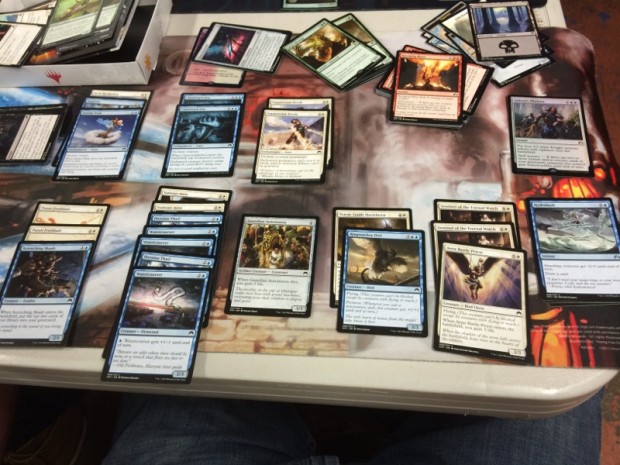 Blue has a lot of good things going for it. [mtg_card]Claustrophobia[/mtg_card] is a great removal spell; it doesn’t kill the creature it targets, but it taps it and keeps it locked down, which is just about as good. There are two [mtg_card]Jhessian Thief[/mtg_card], which can provide a steady stream of cards if I can keep forcing them through. On the other hand, this deck feels like one that performs best when things are already going well for it. If I can keep getting the Thieves through, I will draw extra cards to compound my advantage. If things aren’t going so well, It may be tough to catch back up.
Blue has a lot of good things going for it. [mtg_card]Claustrophobia[/mtg_card] is a great removal spell; it doesn’t kill the creature it targets, but it taps it and keeps it locked down, which is just about as good. There are two [mtg_card]Jhessian Thief[/mtg_card], which can provide a steady stream of cards if I can keep forcing them through. On the other hand, this deck feels like one that performs best when things are already going well for it. If I can keep getting the Thieves through, I will draw extra cards to compound my advantage. If things aren’t going so well, It may be tough to catch back up.
The green, blue, and black all had a lot to offer, and it was tough to make a choice. Ultimately, I started out with the white-blue build. Two [mtg_card]Claustrophobia[/mtg_card] and two [mtg_card]Suppression Bonds[/mtg_card] (with [mtg_card]Totem-Guide Hartebeest[/mtg_card]!) were too much to ignore. Unfortunately, I got stomped in game one of my first match, thanks in part to drawing a few too many lands.
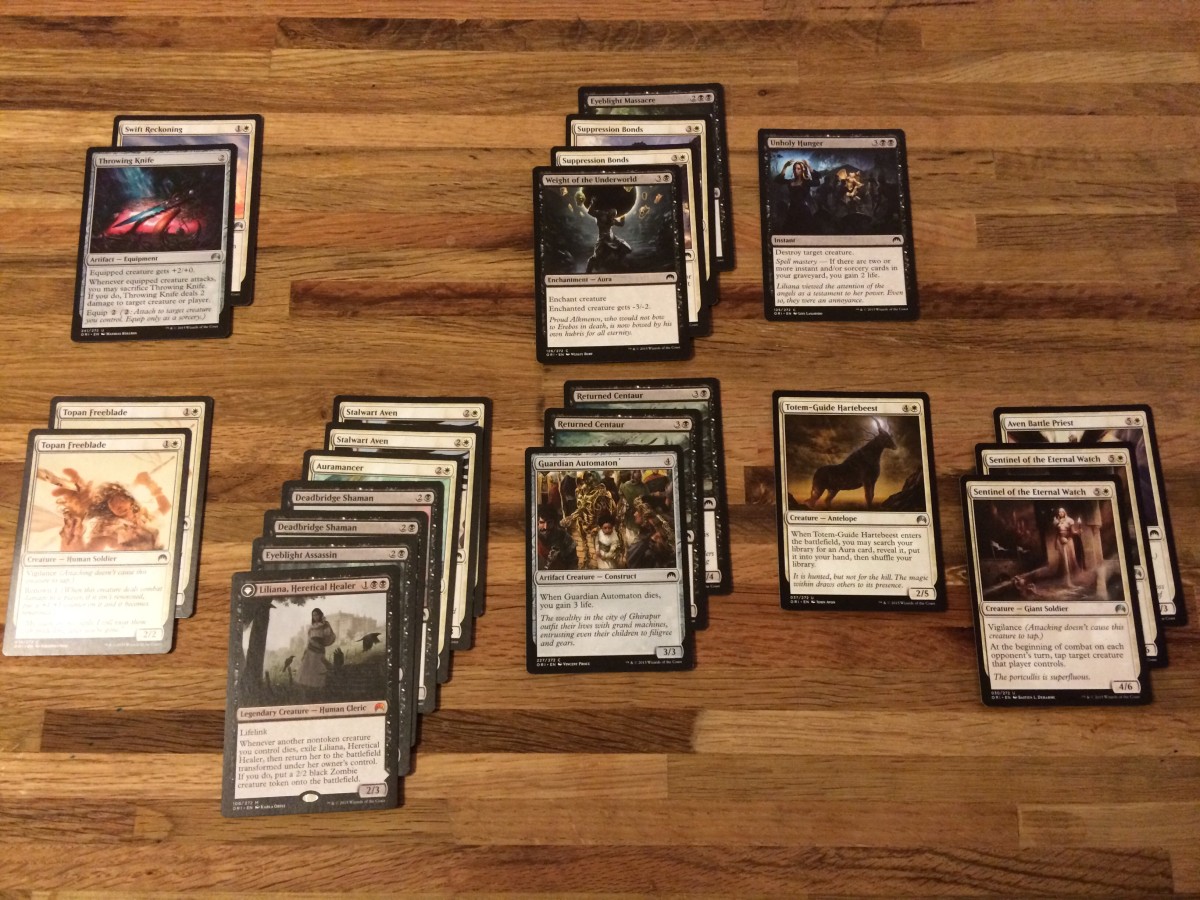 In between games I sideboarded—that is, I exchanged some cards in my deck with other cards in my pool—to make this black-white deck. (Well, this, plus nine Plains and eight Swamps.) My opponent’s deck was red-white and very aggressive. The black cards added a lifelink creature in [mtg_card]Liliana, Heretical Healer[/mtg_card], an [mtg_card]Eyeblight Assassin[/mtg_card] that could pick off his 2/1 creatures, and [mtg_card]Eyeblight Massacre[/mtg_card], which would help sweep up Goblin tokens from [mtg_card]Dragon Fodder[/mtg_card].
In between games I sideboarded—that is, I exchanged some cards in my deck with other cards in my pool—to make this black-white deck. (Well, this, plus nine Plains and eight Swamps.) My opponent’s deck was red-white and very aggressive. The black cards added a lifelink creature in [mtg_card]Liliana, Heretical Healer[/mtg_card], an [mtg_card]Eyeblight Assassin[/mtg_card] that could pick off his 2/1 creatures, and [mtg_card]Eyeblight Massacre[/mtg_card], which would help sweep up Goblin tokens from [mtg_card]Dragon Fodder[/mtg_card].
This worked much better. Of course, I didn’t draw too many lands, and in game two, my opponent had a poor draw. In game three, [mtg_card]Deadbridge Shaman[/mtg_card] and [mtg_card]Returned Centaur[/mtg_card] held the fort until both [mtg_card]Sentinel of the Eternal Watch[/mtg_card] came down; at that point, my opponent’s attack was completely halted, and I cleaned up with a [mtg_card]Stalwart Aven[/mtg_card].
[As an aside, for those who are especially serious about getting better at Magic: learning to sideboard in limited, especially in sealed, is a very important skill to pick up. As Tom Ross has written, it is basically impossible to “perfectly” build your deck in the time allotted for deck construction. In particular, the last few cards to make your deck or be cut from it will almost always be judgment calls—cards that might be good in some situations, but won’t be good in others. It’s easy to swap those out when your opponent’s deck calls for it. Moreover, it’s important to recognize when sideboarding entire colors will restructure your deck favorably for a particular matchup. On rare occasions, you can build two entire decks and swap between them.]
Of course, if you’re a more casual player and you’re just looking to have fun at your prerelease, don’t worry about that too much. If it occurs to you that a card you left out of your deck would be better, definitely swap it in. (Prereleases let you change your deck between rounds—in other tournaments, you’ll have to return to a particular deck construction for game one of each round.)
In my case, I didn’t start playing the [mtg_card]Auramancer[/mtg_card] right away, but added it once I realized [mtg_card]Returned Centaur[/mtg_card] could flip [mtg_card]Suppression Bonds[/mtg_card] or [mtg_card]Weight of the Underworld[/mtg_card] into my graveyard. It just goes to show that everyone can miss particular synergies. Be open to the possibility that you may have built your deck slightly off and be willing to change when you need to.
Speaking of newer, more casual players looking to have fun, though—how was Tim Lanning doing?
 I see. (That’s Tim’s lonely [mtg_card]Nantuko Husk[/mtg_card] on the left, facing down a [mtg_card]Gilt-Leaf Winnower[/mtg_card] and a renowned [mtg_card]Rhox Maulers[/mtg_card].)
I see. (That’s Tim’s lonely [mtg_card]Nantuko Husk[/mtg_card] on the left, facing down a [mtg_card]Gilt-Leaf Winnower[/mtg_card] and a renowned [mtg_card]Rhox Maulers[/mtg_card].)
In the end, Tim went a noble 0-4 in his matches. In his defense, he built a very good black-green deck for a newer player. His card evaluation was spot-on; he seemed to get tripped up by not being as familiar with some of the cards, which is completely understandable.
I managed 2-1 with my deck, then drew with my last opponent to lock us both into three packs each. We made good use of them, too—Pack Wars!
If you’ve never had the pleasure, Pack Wars is a fun casual format. You open a booster pack, and then—without looking at its contents—add three of each basic land. Shuffle and play. It’s a silly format; games are often decided by a single unopposed flyer or by color screw. But it’s wild and unpredictable, and on the whole a great way to have fun while you see what you opened.
In our case, Tim and I, along with my roommate Aaron, had a pitched three-sided battle which was ultimately determined by Tim’s [mtg_card]Hangarback Walker[/mtg_card]—pretty great when you cast it as a 5/5 for 10 mana that guarantees 5 1/1 flying Thopters if you manage to kill it.
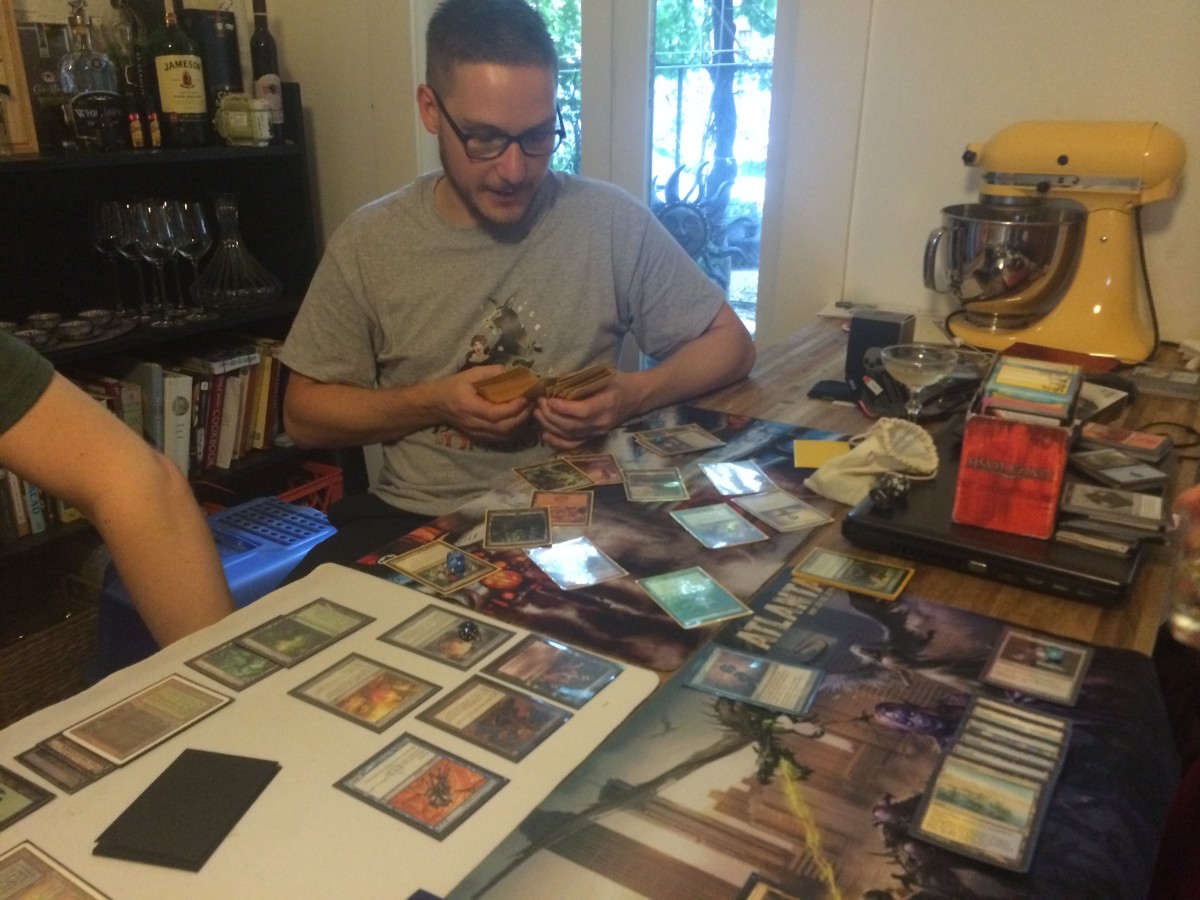 Afterward, we ran it back with a game of Commander: Aaron with [mtg_card]Damia, Sage of Stone[/mtg_card], Tim with my [mtg_card]Mayael the Anima[/mtg_card] deck, and me with [mtg_card]Isperia the Inscrutable[/mtg_card]. Aaron’s bevy of card-draw effects gave him an insurmountable advantage (check the [mtg_card]Consecrated Sphinx[/mtg_card] in the foreground there! And then try resolving that and [mtg_card]Anvil of Bogardan[/mtg_card] and [mtg_card]Teferi’s Puzzle Box[/mtg_card] in the same turn). The enormous monsters in Tim’s deck did make a good show of it, though.
Afterward, we ran it back with a game of Commander: Aaron with [mtg_card]Damia, Sage of Stone[/mtg_card], Tim with my [mtg_card]Mayael the Anima[/mtg_card] deck, and me with [mtg_card]Isperia the Inscrutable[/mtg_card]. Aaron’s bevy of card-draw effects gave him an insurmountable advantage (check the [mtg_card]Consecrated Sphinx[/mtg_card] in the foreground there! And then try resolving that and [mtg_card]Anvil of Bogardan[/mtg_card] and [mtg_card]Teferi’s Puzzle Box[/mtg_card] in the same turn). The enormous monsters in Tim’s deck did make a good show of it, though.
So: the prerelease was sweet, but what did we learn? Well, the format was a bit faster than I had originally thought. I think this is in part because red and white seem like the strongest colors for sealed, and they have a lot of high-quality renown creatures between the two of them. Renown can make it difficult for the player on defense—if your opponent’s first renown creature hits you, it’s likely that creature can keep attacking, and it makes blocking decisions tough for their other creatures. And in sealed, unlike in draft, everyone can play their best colors—so everyone who opened good red and white could play it, and got a fast deck as a result.
Flying mattered a bit, though perhaps not to the extent I thought it might. There were fewer Thopters flying around than I thought there might be, and big renown attackers put pressure on opponents who are messing around with 1/1 flyers. That said, my defensive white-black deck sure liked having a few Aven Stalwarts to attack with. And when your renown creatures don’t have great attacks right away, they tend to sit and stare at each other across the board. That can lead to stalled board states where neither player has profitable attacks. In those situations, flyers are great.
Having done a few drafts at this point, it seems white and red are unusually deep in Magic Origins. In one group, white supported five out of six drafters. In another, red supported four of six. On the other hand, I’ve found that green and blue have fewer attractive “move-in” cards—their cards’ power is a little flatter, so aside from powerhouses like [mtg_card]Rhox Maulers[/mtg_card] and [mtg_card]Wild Instincts[/mtg_card] or premier uncommons like [mtg_card]Whirler Rogue[/mtg_card], it can be hard to know when you should shift your draft into green or blue. That doesn’t mean green or blue are bad, just that you should draft them with a plan in mind, and move when you see the cards which advance that plan.
I hope you enjoyed reading about Tim’s and my prerelease experiences! Sound off in the comments (or tweet me @cutefuzzy_): how did your prerelease go? What are your impressions of the format? And would you be able to beat Tim Lanning in a game of Magic?


I HAD MAD MANA ISSUES, BRO! IT HURT SO BAD!